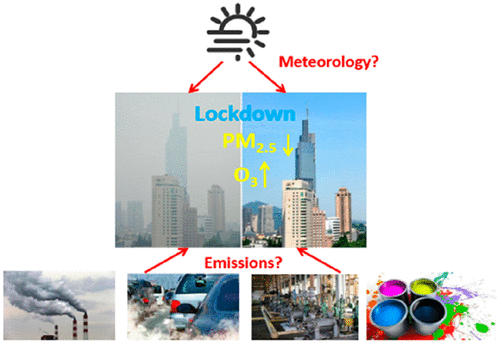当前位置:
X-MOL 学术
›
Environ. Sci. Technol. Lett.
›
论文详情
Our official English website, www.x-mol.net, welcomes your
feedback! (Note: you will need to create a separate account there.)
Driving Forces of Changes in Air Quality during the COVID-19 Lockdown Period in the Yangtze River Delta Region, China
Environmental Science & Technology Letters ( IF 8.9 ) Pub Date : 2020-09-14 , DOI: 10.1021/acs.estlett.0c00511 Ting Liu 1 , Xueying Wang 1 , Jianlin Hu 1 , Qian Wang 2 , Jingyu An 2 , Kangjia Gong 1 , Jinjin Sun 1 , Lin Li 1 , Momei Qin 1 , Jingyi Li 1 , Junjie Tian 2 , Yiwei Huang 2 , Hong Liao 1 , Min Zhou 2 , Qingyao Hu 2 , Rusha Yan 2 , Hongli Wang 2 , Cheng Huang 2
Environmental Science & Technology Letters ( IF 8.9 ) Pub Date : 2020-09-14 , DOI: 10.1021/acs.estlett.0c00511 Ting Liu 1 , Xueying Wang 1 , Jianlin Hu 1 , Qian Wang 2 , Jingyu An 2 , Kangjia Gong 1 , Jinjin Sun 1 , Lin Li 1 , Momei Qin 1 , Jingyi Li 1 , Junjie Tian 2 , Yiwei Huang 2 , Hong Liao 1 , Min Zhou 2 , Qingyao Hu 2 , Rusha Yan 2 , Hongli Wang 2 , Cheng Huang 2
Affiliation

|
During the COVID-19 lockdown period (from January 23 to February 29, 2020), ambient PM2.5 concentrations in the Yangtze River Delta (YRD) region were observed to be much lower, while the maximum daily 8 h average (MDA8) O3 concentrations became much higher compared to those before the lockdown (from January 1 to 22, 2020). Here, we show that emission reduction is the major driving force for the PM2.5 change, contributing to a PM2.5 decrease by 37% to 55% in the four YRD major cities (i.e., Shanghai, Hangzhou, Nanjing, and Hefei), but the MDA8 O3 increase is driven by both emission reduction (29%–52%) and variation in meteorological conditions (17%– 49%). Among all pollutants, reduction in emissions mainly of primary PM contributes to a PM2.5 decrease by 28% to 46%, and NOx emission reduction contributes 7% to 10%. Although NOx emission reduction dominates the MDA8 O3 increase (38%–59%), volatile organic compounds (VOCs) emission reduction lead to a 5% to 9% MDA8 O3 decrease. Increased O3 promotes secondary aerosol formation and partially offsets the decrease of PM2.5 caused by the primary PM emission reductions. The results demonstrate that more coordinated air pollution control strategies are needed in YRD.
更新日期:2020-11-12











































 京公网安备 11010802027423号
京公网安备 11010802027423号